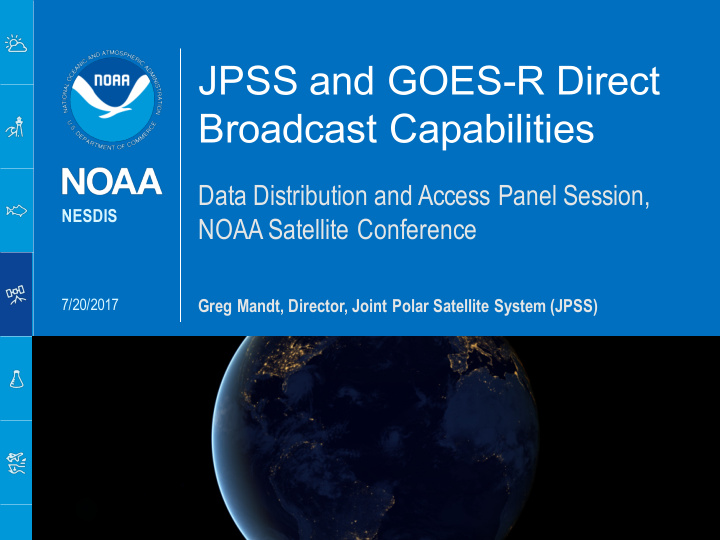



JPSS and GOES-R Direct Broadcast Capabilities Data Distribution and Access Panel Session, NESDIS NOAA Satellite Conference 7/20/2017 Greg Mandt, Director, Joint Polar Satellite System (JPSS)
Direct Broadcast and Direct Readout Services JPSS Direct Broadcast (DB) and Direct Readout Services § High Rate Data (HRD) § NOAA Direct Broadcast Real-Time Network (Testbed) § Field Terminal Support (FTS) § Community Satellite Processing Package (CSPP) GOES-R Series DB and Direct Readout Services GOES Rebroadcast (GRB) § High Rate Information Transmission (HRIT) Service and the Emergency § Managers Weather Information Network (EMWIN) CSPP Geo § 2
S-NPP and JPSS-1 High Rate Data JPSS Direct Broadcast (DB) provides real- time access to regional users and includes: Field Terminal Support (FTS) web portal, § provides software and hardware configuration allowing user to process Db data (http://noaasis.noaa.gov/NOAASIS/ml/jpss- fts.html) Community Satellite Processing Package § (CSPP), an open source software to produce SDRs and EDRs NOAA Direct Broadcast Real-Time Network § JPSS funded antenna in Puerto Rico (DBRTN) to demonstrates impact of low Orbital 2.4 M X/L band antenna latency infrared and microwave sounder data to NOAA’s National Weather Service (NWS) Numerical Weather Prediction (NWP) computer models 3
Direct Broadcast Real-Time Network (DBRTN) Antenna Sites 4
Importance of Latency in NWP Rap DBRTN 30 minute latency allows for close to 90% of polar data to be ingested in NWP 5
GOES-R Series GOES Rebroadcast § The GOES Rebroadcast (GRB) downlink is standards-based, making use of the following protocols: § Digital Video Broadcasting (DVB-S2) § Consultative Committee for Space Data Systems (CCSDS) Advanced Orbiting Systems (AOS) § Space Data Link Protocol § CCSDS Space Packet Protocol § GOES-R Product Definition and Users' Guide (PUG) Volume 4 http://www.goes-r.gov/users/docs/PUG-GRB-vol4.pdf § GRB Downlink Specification http://www.goes-r.gov/users/docs/GRB_downlink.pdf 6
GVAR and GRB Comparison GOES Variable (GVAR) GOES Rebroadcast (GRB) Full Disk Image 30 Minutes 5 Minutes (Mode 4) 15 min (Mode 3) Other Modes Rapid Scan, 3000 km X 5000 km (CONUS: 5 minute) Super Rapid Scan 1000 km X 1000 km (Mesoscale: 30 seconds) Polarization None Dual Circular Polarized Receiver Center Freq 1685.7 MHz (L-Band) 1686.6 MHz (L-Band) Data Rate 2.11 Mbps 31 Mbps Antenna Coverage Earth Coverage to 5 0 Earth Coverage to 5 0 Data Sources Imager and Sounder ABI (16 bands), GLM, SEISS, EXIS, SUVI, MAG Space Weather None ~2 Mbps Lightning Data None 0.5 Mbps 7
GOES-R HRIT/EMWIN • Emergency Managers Weather Information Network (EMWIN) - Direct Service that provides users with weather forecasts, warnings, graphics, and other NWS data • High Rate Information Transmission (HRIT) Service broadcasts low-resolution GOES imagery • Combines former LRIT and EMWIN services from previous GOES • Receiver frequency 1694.1MHz and data relay capacity of 400kbps • Receiver specifications: http://www.goes-r.gov/users/hrit-links.html 8
Thank you! 9
Joint Polar-orbiting Satellite System (JPSS) Direct Broadcast JPSS-1 launch— Q4 FY 2017 Future configuration with SNPP and JPSS-1, 50 minutes apart along same track 10
NOAA Direct Broadcast Real-Time Network (DBRTN) § North American Component of WMO DBNET Program Adheres to WMO “Guide to the Direct Broadcast Network (DBNet) For Near Real-Time Relay of Low Earth Orbit Satellite Data” § Sounder data to be assimilated by the National Centers for Environmental Prediction (NCEP) in FY 2017 Q4, and will shortly be added to GTS (CrIS, ATMS, IASI) to increase the percentage of polar data used models at major meteorological centers and provide backup in case of anomalies in polar global processing § Heritage ATOVS still provided through RARS, but new DBNET will soon include ATOVS 11
GOES-16 Products on GRB Level 1b products: § Radiances from Advanced Baseline Imager (ABI): 16 Bands; Full Disk, CONUS, and Mesoscale § Solar Imagery from Solar Ultraviolet Imager (SUVI) § Solar Flux from the Extreme Ultraviolet and X-ray Irradiance Sensors (EXIS) § Energetic Heavy Ions from the Space Environment In-Situ Suite (SEISS) Level 2 products: § Geostationary Lightning Mapper (GLM) 12
Recommend
More recommend